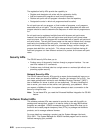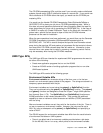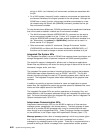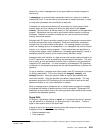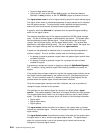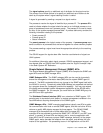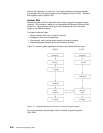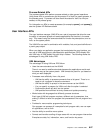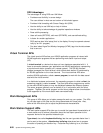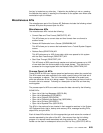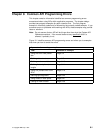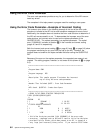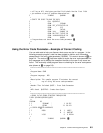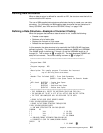DDS Advantages
The advantages of using DDS over UIM follow:
Provides more flexibility in screen design
The user defines in what row and column a field should appear.
Provides initial formatting with Screen Design Aid (SDA)
Has the ability to use UIM help or help in folders
Has the ability to take advantage of graphical operations windows
Does subfile processing
Uses edit code (EDTCDE), edit word (EDTWRD), and user-defined editing
Is faster for smaller applications
DDS requires less initial setup (that is, the display file may be opened automat-
ically by an HLL program).
Can also imbed HyperText Markup Language (HTML) tags into the data stream
that is sent out
Virtual Terminal APIs
The virtual terminal APIs allow your AS/400 application programs to interact with
AS/400 application programs that are performing work station input and output
(I/O).
A virtual terminal is a device that does not have hardware associated with it. It
forms a connection between your application and AS/400 applications, representing
a physical work station (possibly on a remote system). The OS/400 licensed
program manages the virtual terminal, which directs work station I/O performed by
an AS/400 application to the virtual terminal. The virtual terminal APIs allow
another AS/400 application, called a server program, to work with the data associ-
ated with the virtual terminal.
In a distributed systems environment, the requesting program is called a client; the
answering program is called a server. The client and server programs may reside
on the same AS/400 system or may be distributed between two different systems.
The server program generally runs on behalf of (or in conjunction with) the client
program. Together, the server program and the client program allow a work station
to be supported as if the work station were connected locally.
Work Management APIs
This group of APIs helps you to better manage the work on your system. The APIs
let you keep track of the jobs and the things associated with those jobs. Also,
some of the APIs allow you to adjust the performance characteristics.
Work Station Support APIs
The work station support APIs allow you to control the type-ahead characteristics of
a work station and to retrieve information about the last output operation to the
requester device for the specified interactive job.
Type-ahead, also called keyboard buffering, lets the user type data faster than it
can be sent to the system. Attention key buffering determines how to process
the action of pressing an Attention key. If attention key buffering is on, the Atten-
8-28 System API Programming V4R1



